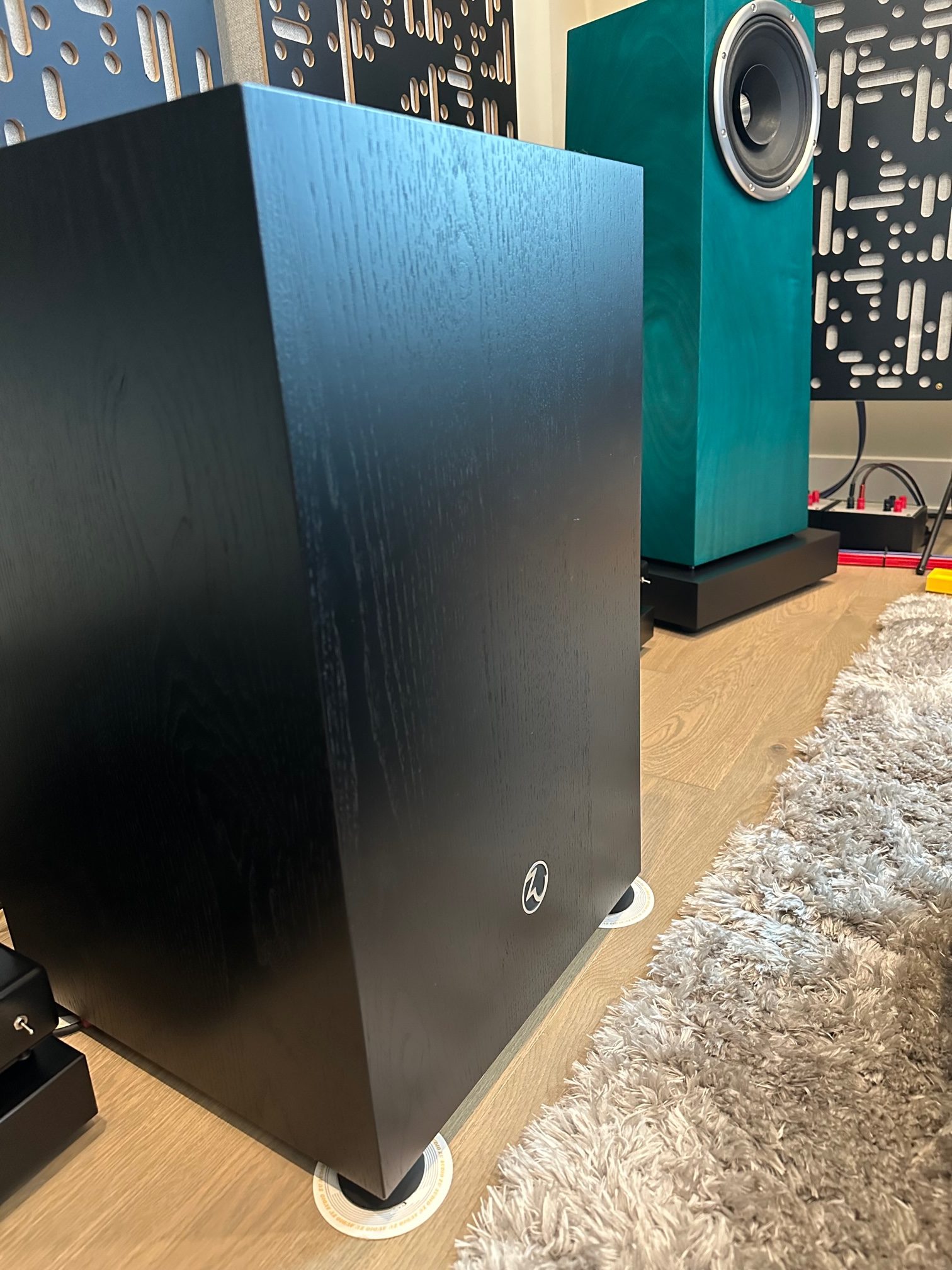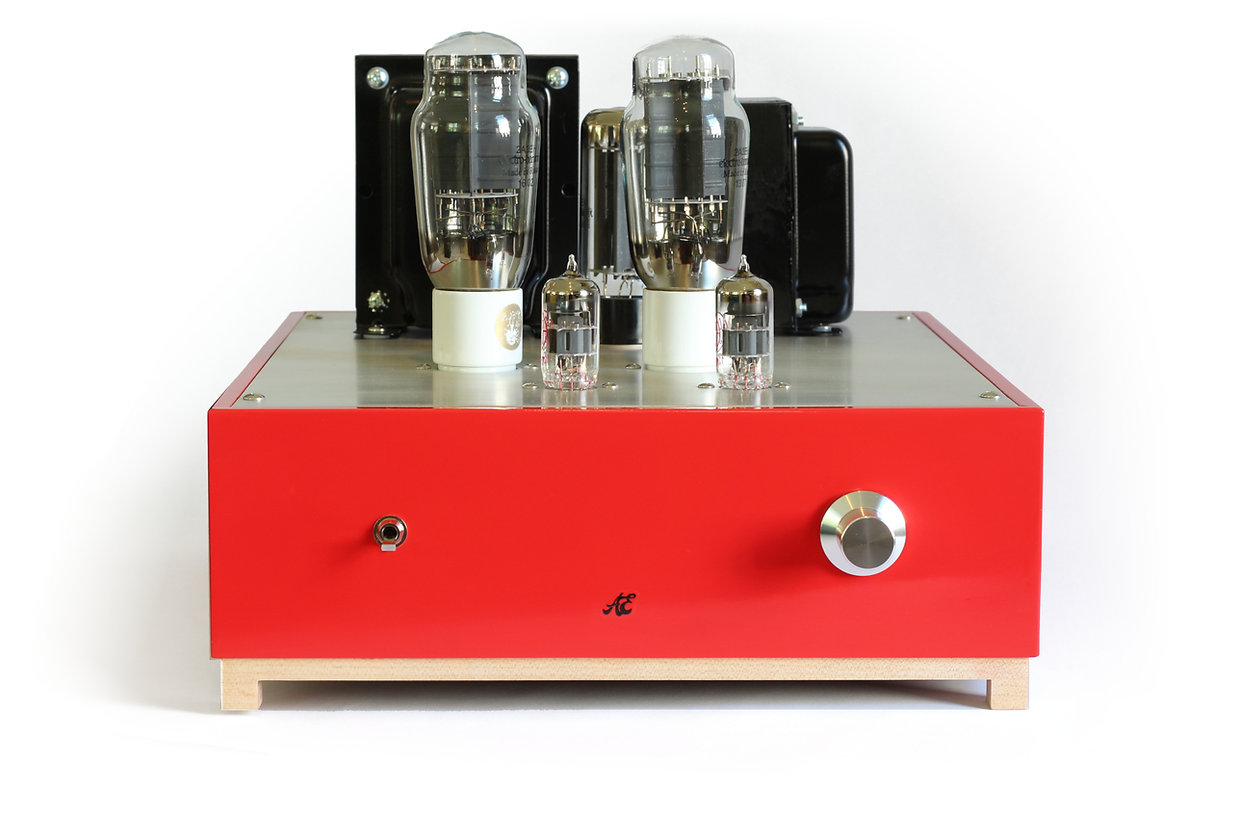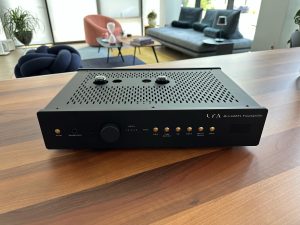A little while ago I reviewed the Wells Audio Cipher. I asked Jeff Wells, the owner of Wells Audio, to tell me more about the Cipher, and he more or less described it as his preamp circuit, with a single fixed input coming from the DAC. I was so impressed with the smooth analog nature of his DAC that I asked him if I could review his preamp. A few months later, a Commander Level II arrived at my door.
The Commander Level II is Jeff Wells' mid-range preamp. The standard level I, sells for $3999, the level II (my unit) sells for $9000, and the Level III sells for $18,000. Each version has the same base design and circuit, and each upgrade introduces higher end and more expensive discrete parts into the build process. According to Wells Audio these improvements lower the noise floor, increase the dynamic range, and dramatically improve the experience. While I have not heard the Commander I or III, based on the part differences between the models I have no doubt that they each sit in their own performance category.
One thing that I think is unique about Wells Audio is their willingness to work with their customers. Jeff and I spent a lot of time on the phone, and he told me about all the different tweaks and changes he could make to the preamp if requested. He is able to make changes like lowering or raising the gain, adding different inputs and outputs, and many other changes. Jeff is able to accommodate these custom requests because he and his team build their products entirely in house. I did point out to Jeff that there are plenty of companies that build in house, but are not willing to customize their products for their customers, and he laughed and said "well I guess we are different." This customer centric difference is something that should not be taken for granted. During this review I got to experience his service first hand, and it was impressive. In my area UPS is a little more violent with packages than they should be, when the first review sample showed up, and did not work correctly due to damage during transit, a label was sent and the Commander was taken back for a full round of testing. When the second one showed up, and I got a hum on my outputs, a label was sent, and the preamp was fully tested, and modified to prevent the hum. Each of these times, I didn't even have to ask, Jeff just said "it's not right let's fix it." At these prices, it's this type of service that we should come to expect, however, I can only count one, maybe two other companies that treat people this way.
Unboxing the Commander
Like many of Jeff's other products, the Commander's case is built out of acrylic paneling, with side vents made of metal mesh. The result when you pull it out of the box is a product that is lighter than you would initially expect. Lighter does not mean fragile or flimsy, the Commander is solidly built and has no give.
The front of the Commander has a row of buttons along the bottom, giving you complete control over the unit. There is a seeing eye tube centered on the chassis that both acts as a way to visualize the volume level, and as an indicator that the commander is on. A combination of gold, silver, black, and white is used across the front of the Commander. This is not an understated device on your rack. It will call attention to itself.
Flipping the Commander around, you are presented with a plethora of input and output options, as one would expect from a preamp of this price. On the input end you have one XLR input, three RCA inputs, a tape loop, and a home theater bypass. For outputs, you have two variable RCA outputs, one fixed RCA output, and one variable XLR output. One thing that is very exciting is the customization of the inputs and outputs at time of order, so this preamp can be built to match exactly what you think your system may need. What is described above is the standard complement.
The preamp itself is a single-ended design. Jeff is not the biggest fan of balanced designs, as he believes they often sound very similar, linear, lifeless, and a little bland. He attributes this to the fact that balanced designs cancel even harmonic distortion, which our human ears tend to like. I personally have always gone back and forth on this, but I am a big believer that a well designed single-ended system can sound just as good as any balanced system, if not better. What this means is that the XLR inputs and outputs on the Commander are not balanced, they are simply connectors, and they short one pin to ground. Think of these as compatibility connectors. Inside the preamp are two sets (four total) of 12BH7 tubes. Jeff specifically chose these tubes for their linearity and because the modern remakes of these tubes is exceptional. Jeff believes the TAD tubes he sources and places into the Commander are the best options out there from a noise and tone perspective. The first two 12BH7s act as the gain stage for the preamp's 16db of gain, and the second two 12BH7s allow for the preamp to invert its polarity. To do this, he uses a technique called split load triode. As the reviewer, I am not going to claim to understand the details, but according to Wells Audio, a split load triode is apparently the closest thing to the ideal phase splitter, and it did seem to be transparent when engaging and disengaging. To achieve the electrical requirements to use a split load triode, Wells Audio employs a buffer which is a tube transistor hybrid design. I want to call out that this level of attention to detail is often times not seen even at this price point, and it is extremely impressive.
What Wells Audio has built with the Commander line is a truly modern tube preamplifier. You can see this with the phase splitter and buffer design described above, but also in other parts of the the product design such as the power supply. Wells Audio uses regulators on both the filament and plate supplies. The plate supplies themselves are fully discrete and are made up of four independent stages. Generally, in the world of tube audio, there are two thought processes. The first is to design using what was available in the 1960s and 1970s, and the second is that tubes are awesome, but we can make them better with modern technology. Wells Audio clearly falls into the second camp, and I will be honest, I cannot argue with the results.
The most important job a preamp does is volume control. Like all other parts of the Commander this was also not an afterthought. The volume control for the Commander is a relay-controlled resistor ladder volume control made by the fine folks at Khozmo. For those who have not heard of this brand, they are a small manufacturer of what is considered the very best in pre-made volume controls. In my own testing, volume changes were always smooth, I did not hear clicking through my speakers, and I never found myself wanting for a missing volume step. The Commander also offers a remote control. It is a custom remote, made of metal, and it overall feels good in the hand. It does not allow for on-off controls, but does allow for source selection, polarity inversion, and volume control. Overall, I found the remote good, and a step above what some others include with their preamps.
So far everything I have described, is standard on the Commander Level I, and is true for all models of the Commander, the Commander Level II, which is the unit I have for review, adds in Bybee AC purifiers and Rike capacitors, best caps as output coupling capacitors. It also has upgraded XLR and RCA connectors.
Review System
- Speakers: Zu Audio Soul Supremes, Custom Built 3-way horn loaded loud speakers
- Amplifiers: Ampsandsound Zions (Citation V Mono Blocks)
- Source Components: DCS Rossini, Roon Core, Chord Hugo 2
- Cabling: Wywires Platinum Interconnects and Wireworld Eclipse 8 Interconnects
- Power Conditioning: PS Audio P12 and Core Power Deep Core
The Commander was broken in over about 150 - 200 hours before any critical listening was done. All components not under review in the system at this point have well over 500 hours on them.
Listening Impressions
Both of my speakers are relatively high efficiency with sensitivity at 99dB/watt and 94dB/watt respectively. The most important question when connecting a preamp, especially one with a gain greater then 12dB, is will it add audible noise? Once the Commander was placed into my system I gave it 10 minutes to warm-up, and came back to my listening seat. I sat for a few minutes just listening to the room, and I heard silence. The next thing I did was get up and listen to the tweeters of my speakers, placing my ear within 1 foot of the tweeter. At this distance I could hear a bit of noise, it was subtle, and not much louder then the DCS Rossini alone, but there was a slight increase in noise. To be clear this increase was expected, and I will be honest I was impressed that it's so minor.
When listening to my system with the Commander in it, I was struck by how organic and smooth it sounded. To be clear I don't mean smooth as in rounded, or not detailed, I simply mean smooth. Dynamic transitions felt natural and unforced, the treble extension never felt grainy, and bass felt taut, but maybe not quite precise as it did without the Commander. I was also struck by the space that was created in the recordings. The DCS Rossini does an excellent job with spatial presentation, however, with the wrong recording I have noticed my system can sound a little thin. The Commander seemed to always ensure that recordings had the right amount of weight and presence, so that thin nature became a much rarer occurrence. I also noticed the sound stage took a step forward, likely due to the gain, and the result was a stage that was still incredibly wide, but maybe a little less deep. The reward was presence and immediacy, which is a reasonable trade off in a world where nothing is ever free.
Starting off with Alanis Morissette's "Reasons I Drink," I sat back and turned up the volume. I always choose to use this song because of the bass line, the way bass snaps back, it has become a way for me to see if there is any rounding or bloom in the bass region. The system with the Commander played beautifully. The bass region was a little stronger and reached a little deeper, the snap that I was looking for was present, and overall, the song had a heavier weight to it. This weight did not cloud the mid-range, her voice was still clear and punchy, and you could still get a sense for the space around her. As noted above she sounded a bit more forward than my system normally renders her, but this was expected and was a bit more engaging. I did notice some of the spatial detail that I have come to take for granted from the Rossini was lost, but the weight, and enhanced tonal characteristics that the Commander added was a reasonable trade off.
Another one of my favorites, Mika's "Popular" off of his Live at Brooklyn Steel album, presented incredibly well on the Commander. Here the dulling of some of the Rossini's fine detail was an enhancement instead of a detractor. While I love this song, it can present as grainy from time to time, just because of the way it was recorded. With the Commander in the system, none of the grain was present, instead the grain was replaced by warmth. The overall expression was thicker, but it was still fast and felt accurate. I would put the Commander about two clicks to the right of neutral, it is a little warm, but in all the right ways. For me though, the thing that struck me was the dynamic presentation, everything just felt bigger. The sound stage felt taller, the bass felt deeper, and the crowd in the background seemed larger and more engaged. Turning the volume up or down had little change in the presentation of the Commander, and I found myself sitting what felt like between 20% - 50% of max volume for most of my listening.
The impact of the Commander seemed to be constant with other gear as well. Plugging the Chord Hugo 2 into the Commander resulted in a warmer, more spatially open presentation. I really like the Hugo 2; however, I find it leans to the left of neutral and with the wrong equipment can be really challenging to listen to. The Commander really tamed the negative edges of the Hugo 2, and let its excellent rendering of detail and precision shine through. Similarly, when swapping speakers between my Zu Soul Supremes and my custom built 3-way horns, I noticed very similar affects. My 3-way horns can be harsh, this is partially due to my room and lack of proper room treatments. While the Commander did not remove all of the harsh notes, it did noticeably reduce them and dramatically improved my listening experience with my 3-ways, especially when used with a poorly recorded track.
Finally listening to Carmen Gomes' "Mary Ann," on Sings the Blues, I was struck by how well the Commander was able to render detail while breathing warmth into the presentation. This album is easily one of the highest quality recordings in my collection, it presents vocals, cymbals, and space in a way that I rarely hear, and sounds exceptional on my system when used with just the DCS Rossini. With the Commander in the middle, additional weight is applied to both her voice and the cymbals. The result is a fuller sound that feels more firmly rooted in the space around you. The bass also became a little more defined, but in this case, I felt it lost a little bit of its detail. Overall, this song presented exceptionally with the Commander in the chain, and while both renditions had their pros and cons, I found myself going back to this song again and again throughout my review period. It was just that good.
Possible Improvements
The Commander Level II is extremely good at what it does, and as a preamp in a vacuum it is very hard for me to fault its performance. However, there are some things that I would love to see Wells Audio improve on in the future. The first is the case work itself. As I said in the beginning of the review, the Commander's case is assembled out of acrylic panels. While it looks great, at the end of the day it's an acrylic case, which is not what I would expect at its retail price. I would love to see Wells Audio bring the metal work that they use for some of their power and integrated amps to the Commander.
The second thing, is the lack of a volume knob on the Commander's front panel. While the Commander does have volume buttons, they react relatively slowly, so the ability to quickly walk up and adjust the volume from 60% to 20% just does not exist. It is also harder to gauge relative volume position. The seeing eye tube helps, however, I found it quite hard to gauge where I was in the volume spectrum when looking at the seeing eye tube (where a volume dial with a hard stop at the ends would have been more accessible).
Finally, I would have liked to see input and output transformers included as standard on the Commander for XLR in and XLR out. Jeff and I did discuss this, and his perspective is that input and output transformers will only degrade the signal. This does not match my personal experience with input and output transformers, however I fully respect that the sound signature of transformers is not for everyone.
Conclusion
The Commander Level II is really quite special. It is a completely custom built, state of the art, modern tube preamplifier. It exhibits an attention to detail rarely seen, even at this price point, and is built in the United States, by a small and caring team who stand behind their products.
The Commander Level II at this price point is not short on competition, but the only competition I can think of is more expensive than the Commander Level II. Specifically, the Mola Mola Makua and the now discontinued MC1100 are the only preamps that I can think of that I would compare performance wise to the Commander Level II. Both of these preamps are at least 25% more expensive, but they do offer different value propositions that may make their additional cost justifiable, depending on your personal priorities. For example, both of these preamps are end to end balanced designs, and the Mola Mola offers an incredible control experience.
Ultimately, if you are looking for a tube-based linestage, made with state-of-the-art technology, that is completely customizable during the build process, then as far as I know the Commander is in a club of one. It is truly enjoyable to listen to, and will serve as the Command and Control module of your stereo system for many years to come. Thank you, Jeff and the Wells Audio team, for allowing me to review the Commander Level II.
Commander Level II
Retail: $9000
Wells Audio












































